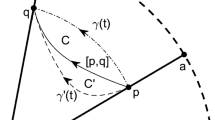Abstract
On a flat plane, convexity of a set is preserved by both radial expansion and contraction of the set about any point inside it. Using the Poincaré disk model of hyperbolic geometry, we prove that radial expansion of a hyperbolic convex set about a point inside it always preserves hyperbolic convexity. Using stereographic projection of a sphere, we prove that radial contraction of a spherical convex set about a point inside it, such that the initial set is contained in the closed hemisphere centred at that point, always preserves spherical convexity.

Similar content being viewed by others
References
Beardon, A.F.: The Geometry of Discrete Groups. Springer, New York (1982)
Beardon, A.F., Minda, D.: The hyperbolic metric and geometric function theory. In: Ponnusamy, S., Sugawa, T., Vuorinen, M. (eds.) Quasiconformal Mappings and their Applications, pp. 9–56. Narosa Publishing House, New Delhi (2007)
Ma, W., Minda, D.: Geometric properties of hyperbolic geodesics. In : Proceedings of the International Workshop on Quasiconformal Mappings and their Applications (2007)
Acknowledgements
We would like to thank M. Xiao for several useful discussions that helped in defining scaling transformations in the Poincaré disk. We also thank the anonymous referee for generous comments that greatly improved this paper.
Author information
Authors and Affiliations
Corresponding author
Ethics declarations
Conflict of interest
On behalf of all authors, the corresponding author states that there is no conflict of interest.
Additional information
Publisher's Note
Springer Nature remains neutral with regard to jurisdictional claims in published maps and institutional affiliations.
Appendix
Appendix
Lemma 1
Let \(f(x) = \tanh ^{-1}\left( \frac{1}{k_1\coth (u_1x) + k_2\coth (u_2x)}\right) \). If \(k_1,k_2 > 0,k_1 + k_2 \geqslant 1\) and \(u_1,u_2 > 0\), then f(x) is concave, that is, \(f''(x) \leqslant 0\) for all \(x > 0\).
Proof
For convenience, denote \(p_i \equiv \coth (u_ix)\). Note that \(p_i \geqslant 1\) for all \(x \geqslant 0\) and \(p_i' \equiv u_i(1-p_i^2)\). Then
where
Note that \(f_1(x), f_2(x) > 0\) for all \(x > 0\). Next,
where
Note that \(f_1'(x), f_2'(x) \leqslant 0\) for all \(x > 0\). The denominator \(f_2(x)^2\) is non-negative. We show that the numerator \(f_1'(x)f_2(x)-f_1(x)f_2'(x)\) is non-positive. Using the Cauchy-Schwarz inequality, we have
Substituting the above inequality in \(f_1'(x)f_2(x)-f_1(x)f_2'(x)\), we get
Inequality (19) follows from the facts that \(f_1'(x) \leqslant 0\) and \(p_1p_2^{-1}+p_2p_1^{-1} \geqslant 2\) for all \(x > 0\). The last inequality follows from \(f_1'(x) \leqslant 0\) and \((k_1+k_2)^2 \geqslant 1\). \(\square \)
Lemma 2
Let \(f(x) = \tan ^{-1}\left( \frac{1}{k_1\cot (u_1x) + k_2\cot (u_2x)}\right) \). If \(k_1,k_2 > 0, k_1+k_2\geqslant 1\), and \(u_1,u_2 > 0\), then f(x) is convex, that is, \(f''(x) \geqslant 0\) for all \(x \in (0,x^*]\) where \(x^* = \frac{\pi }{2}\min (u_1^{-1},u_2^{-1})\).
Proof
For convenience, denote \(p_i \equiv \cot (u_ix)\). Note that \(p_i \geqslant 0\) for all \(x \in (0,x^*]\) and \(p_i' \equiv -u_i(1+p_i^2)\). Then
where,
Note that \(f_1(x), f_2(x) > 0\) for all \(x \in (0,x^*]\). Next,
where
Note that \(f_1'(x), f_2'(x) \leqslant 0\) for all \(x \in (0,x^*]\). The denominator \(f_2(x)^2\) is positive, so we will show that the numerator \(f_1'(x)f_2(x) - f_1(x)f_2'(x)\) is also positive for all \(x \in (0,x^*]\). First we show that
Using the Cauchy-Schwarz inequality, we have
Using the above inequality and Eq. (20) in Eq. (21), we get
as required. We used the fact that \(f_1'(x) \leqslant 0\) to obtain (22). Equation (23) follows by substitution. Since \(x \in (0,x^*]\), we have \(u_ix \leqslant \pi /2\). Also, note that \(f_1(x),k_1,k_2,u_1,u_2 > 0\). Then the last inequality follows from the fact that \(\alpha \cot (k\alpha )\) is decreasing in \(\alpha \) and \(\alpha ^2(1+\cot (k\alpha )^2)\) is increasing in \(\alpha \) for all \(\alpha \) such that \(\alpha > 0\) and \(k\alpha \in (0,\pi /2]\), so that either both terms in the product \(\left( u_1p_1-u_2p_2\right) \left( u_2^2(1+p_2^2) - u_1^2(1+p_1^2)\right) \) are non-positive or both non-negative.
Finally, we substitute (21) in \(f_1'(x)f_2(x) - f_1(x)f_2'(x)\), to get
We used the fact that \(\sqrt{a^2+1}\sqrt{b^2+1}-ab \geqslant 1\) to obtain (24). \(\square \)
Rights and permissions
About this article
Cite this article
Kohli, D., Rabin, J.M. Radial expansion preserves hyperbolic convexity and radial contraction preserves spherical convexity. J. Geom. 110, 40 (2019). https://doi.org/10.1007/s00022-019-0497-8
Received:
Revised:
Published:
DOI: https://doi.org/10.1007/s00022-019-0497-8



